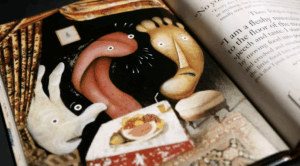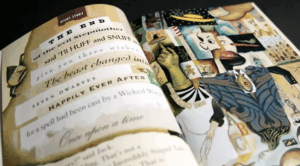When The Stinky Cheese Man and Other Fairly Stupid Tales hit bookshelves in 1992, it turned the world of children’s literature upside down. Written by Jon Scieszka and illustrated by Lane Smith, the book became an instant classic for its witty humor, absurd twists, and playful take on traditional fairy tales. Its title story, “The Stinky Cheese Man,” is a hilarious parody of “The Gingerbread Man,” replacing the sweet, cookie protagonist with a lump of smelly cheese that sends everyone running away instead of chasing after him. But beyond the laughter and clever illustrations lies a deeper principle that has made the story so enduring: it’s a lesson about self-awareness, imperfection, and the power of not taking life—or yourself—too seriously.
The Storyline Behind The Stink
 In the story, the Stinky Cheese Man is baked by a little old lady who, instead of crafting a delightful gingerbread boy, accidentally creates a creature made of old cheese and a slice of bread for a head. As he runs through the countryside, his pungent odor drives everyone away, from the cow to the fox. In the end, his smelly nature leads to his downfall when even his would-be predator refuses to eat him. On the surface, it’s a ridiculous, comical tale that children love for its silliness. Yet, on a deeper level, the story carries a surprisingly mature message about embracing one’s flaws and the absurdities of existence. The Stinky Cheese Man never tries to hide who he is—he simply exists as he was made, stinky and strange, and that authenticity, while isolating, is also oddly admirable.
In the story, the Stinky Cheese Man is baked by a little old lady who, instead of crafting a delightful gingerbread boy, accidentally creates a creature made of old cheese and a slice of bread for a head. As he runs through the countryside, his pungent odor drives everyone away, from the cow to the fox. In the end, his smelly nature leads to his downfall when even his would-be predator refuses to eat him. On the surface, it’s a ridiculous, comical tale that children love for its silliness. Yet, on a deeper level, the story carries a surprisingly mature message about embracing one’s flaws and the absurdities of existence. The Stinky Cheese Man never tries to hide who he is—he simply exists as he was made, stinky and strange, and that authenticity, while isolating, is also oddly admirable.
Scieszka’s book, as a whole, was revolutionary because it broke the “rules” of children’s storytelling. It used metafiction—stories that are aware of themselves as stories—long before that was common in children’s books. Characters interrupt the narrator, pages are out of order, and fairy tales are rewritten in ways that expose their clichés. This irreverence teaches young readers an important principle: that it’s okay to question tradition, laugh at convention, and think creatively. The Stinky Cheese Man encourages readers to see familiar things from a new perspective, a skill that applies far beyond fairy tales. It’s not just about rewriting stories; it’s about reimagining how we approach ideas and challenges in the real world.
Cheesy Characters
 Interestingly, the story’s title character—made from cheese—also invites reflection on one of humanity’s oldest and most fascinating foods. Cheese, historians debate when cheese was invented, but it is believed around 8000 BCE, shortly after humans first began domesticating animals like sheep and goats. The discovery likely happened by accident, when milk stored in animal stomachs naturally curdled due to the enzymes in the lining. From that happy accident, a global tradition was born, leading to thousands of cheese varieties across cultures. The Stinky Cheese Man, though fictional, humorously embodies this long legacy of cheese-making—particularly the infamous “stinky” varieties like Limburger or Roquefort that are loved by some and loathed by others.
Interestingly, the story’s title character—made from cheese—also invites reflection on one of humanity’s oldest and most fascinating foods. Cheese, historians debate when cheese was invented, but it is believed around 8000 BCE, shortly after humans first began domesticating animals like sheep and goats. The discovery likely happened by accident, when milk stored in animal stomachs naturally curdled due to the enzymes in the lining. From that happy accident, a global tradition was born, leading to thousands of cheese varieties across cultures. The Stinky Cheese Man, though fictional, humorously embodies this long legacy of cheese-making—particularly the infamous “stinky” varieties like Limburger or Roquefort that are loved by some and loathed by others.
The Stinky Cheese Man isn’t just a quirky children’s story—it’s a reminder that imperfection, humor, and creativity are essential parts of being human. By twisting familiar tales into nonsense, Scieszka and Smith invite readers to laugh, question, and celebrate the weirdness of life. Just like the cheese that inspired its hero, the story may be a little strange, but that’s exactly what makes it unforgettable.